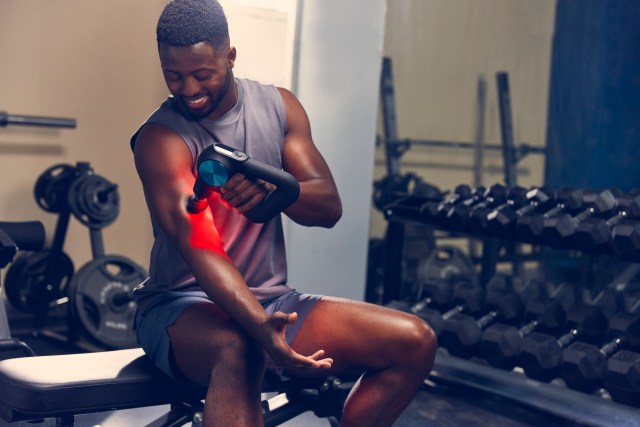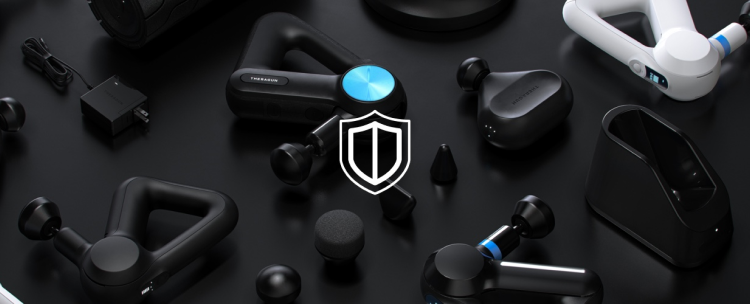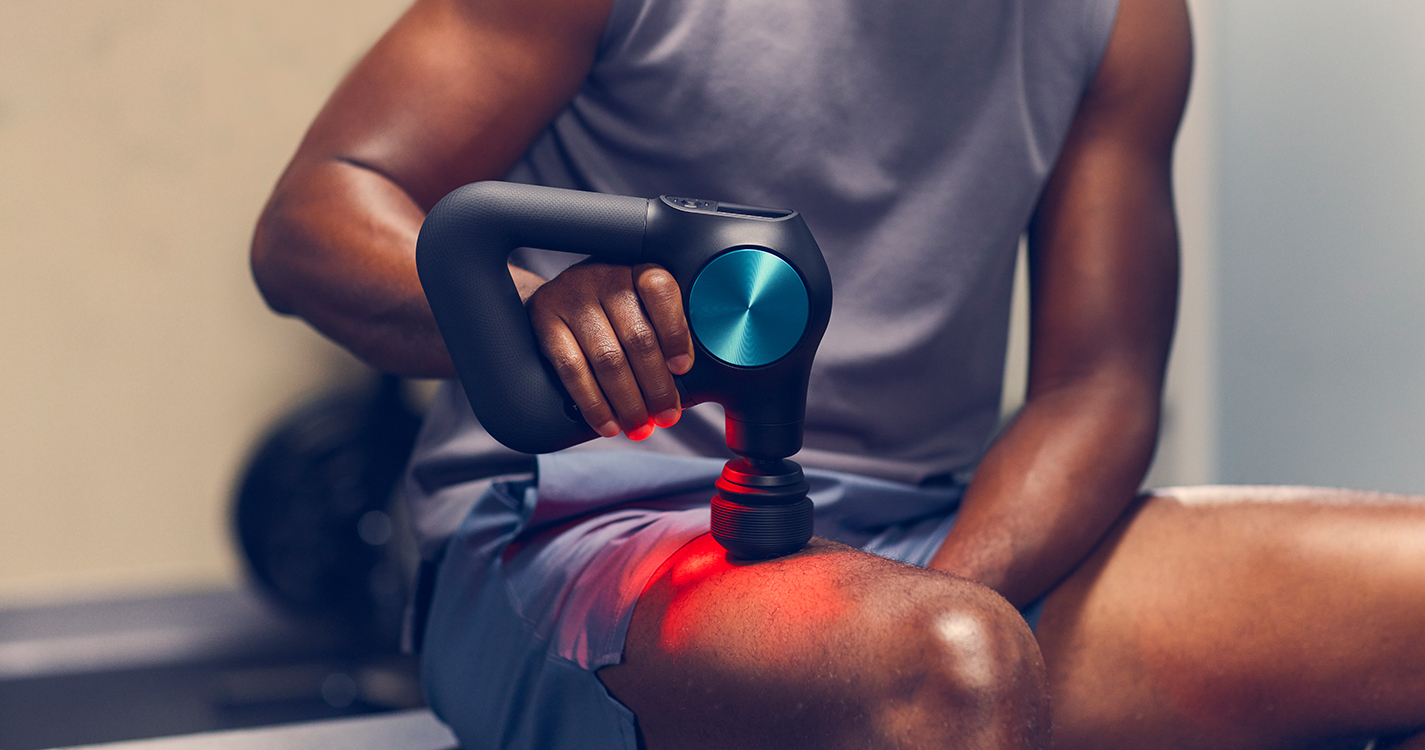Authors: Therabody Scientists: Tim Roberts, MSc; Kyle Silvey, PhD; Michelle Darian, MS, MPH, RD, LDN
What You Should Know About Theragun PRO Plus
Theragun PRO Plus goes where no massage device has gone before, merging six science-backed therapies — percussive therapy, near-infrared LED light therapy, vibration therapy, heat therapy, cold therapy, and breathwork — together, creating a platform to treat the mind and body. Each of the six therapies is scientifically proven to enhance performance and recovery. There is no one-size-fits-all solution for performance enhancement and athletic recovery — so athletes, medical professionals, and athletic trainers alike often leverage multiple therapy types to enhance both. The Theragun PRO Plus device combines these modalities into a single, easy-to-use platform.
Read on to explore the scientific benefits of each of the six treatment modalities Theragun PRO Plus offers — percussive therapy, near-infrared LED light therapy, vibration therapy, heat therapy, cold therapy, and breathwork — and how to get the most out of them to meet your unique body’s needs.
Percussive Therapy
Signature 16mm deep tissue massage treatment targets deep-seated muscle soreness for faster recovery and longer-lasting relief.
Scientific Benefits of Percussive Therapy
Percussive therapy is the rapid and repetitive application of pressure perpendicular to the body. This simultaneously delivers pressure and vibration stimuli to a treatment area, creating therapeutic, science-backed effects.
Most notably, percussive therapy relieves minor aches and pains, reduces muscle tension and stiffness to increase flexibility and mobility, increases circulation, increases muscle oxygenation, reduces delayed onset muscle soreness, and improves power production and recovery. [1, 2, 3] Percussive therapy is often used by athletes, athletic trainers, and other medical professionals to alleviate stiffness and soreness for themselves and those they treat.
When to Use Percussive Therapy
Theragun Percussive Therapy is the most versatile treatment in the Theragun PRO Plus device. You can use percussive therapy to improve your flexibility and mobility as part of a warm-up, improve performance during your workout by using it between sets, and post-workout to accelerate your recovery and prepare for your next session. Percussive therapy isn’t just for athletes — you can also treat tired, tight muscles from everyday demands like traveling, commuting, and sitting at a desk. [1, 2, 3]
Percussive Therapy in Theragun PRO Plus
The Theragun PRO Plus device has five percussive therapy treatment speeds: 1750 RPM, 1900 RPM, 2100 RPM, 2200 RPM, and 2400 RPM.
Percussive therapy can be used with the following five attachments: wedge, standard ball, dampener, thumb, and micropoint. The purposefully designed shape and density of each attachment change the intensity of the treatment. Easily swap out each attachment depending on the treatment area and preference.

Vibration Therapy
Relieve joint pain and treat sensitive areas with vibration therapy.
Scientific Benefits of Vibration Therapy
While percussive therapy reaches deep into the muscle, vibration therapy is a more gentle massage that focuses on the surface of the treatment area; it has local effects like increased circulation and reduced tension and global benefits like reducing pain and increasing relaxation. Local vibration therapy has also been found to increase local blood flow and tissue oxygenation. This makes vibration therapy a better option for more sensitive treatment areas like joints or very sore muscles. [4]
Delayed-onset muscle soreness (DOMS) is commonly experienced in athletes and athletic individuals following strenuous exercise. Symptoms of DOMS include pain, stiffness, soreness, and even swelling. A meta-analysis of 10 studies with 258 participants found that vibration therapy reduces pain at 24, 48, and 72 hours post-exercise. [5]
When used before a workout, vibration therapy can help protect against DOMS as well. It can help reduce swelling, attenuate the biochemical response to muscle damage, and decrease pain associated with delayed onset muscle soreness (DOMS). [5, 6]
When to Use Vibration Therapy
PRO TIP: If you are very sore after a tough workout and percussive therapy is too intense, use vibration therapy as a gentler treatment alternative.
Vibration therapy is best suited for treating sensitive joints and sore areas. Vibration therapy operates at a lower amplitude (depth) than percussive therapy, meaning it does not physically push down on tissue. Think of vibration therapy as a low-intensity option for areas needing a delicate approach. Vibration therapy gently improves circulation and reduces soreness and pain. Consult with a medical professional before using vibration therapy for injury rehabilitation.
PRO TIP: When joints are stiff and sore, use vibration therapy on the muscles around the joint. This can help increase circulation and reduce discomfort without applying direct pressure to sore areas.
Vibration Therapy in Theragun PRO Plus
Theragun PRO Plus offers vibration therapy as a separate, easy-to-use attachment. The attachment is designed to provide static treatments or massage an area that can benefit from vibration therapy. The vibration therapy offers three speeds: low, medium, and high: 47 Hz, 50 Hz, and 53 Hz.
Heat Therapy
Dual percussive and heat therapy loosens stiff muscles and accelerates athletic recovery. [7]
Scientific Benefits of Heat Therapy
Heat therapy is scientifically proven to improve blood flow, relieve stiffness and soreness, and reduce muscle aches and pain. [8]
A strenuous workout that engages muscles that aren’t often used can lead to muscle stiffness and soreness. Muscles become stiff and sore due to restricted blood flow to the fatigued muscles, which allows metabolic waste products to accumulate. Heat therapy can improve blood flow to stiff and sore muscles; increasing blood flow provides fresh, oxygenated blood to the area, helping to alleviate post-exercise muscle soreness and stiffness in athletes. [8]
Using heat therapy tools in massage has been around for many years. New cutting-edge technology allows percussive therapy devices to combine both heat therapy and percussive massage — working together synergistically to provide both modalities and amplify their benefits and maximize athletic recovery. [9]
When to Use Heat Therapy
Use heat therapy after a strenuous workout to maximize athletic recovery benefits. Avoid using heat therapy immediately following an acute injury — as this may prolong the injury.
PRO TIP: Theragun PRO Plus’s heat therapy with percussive therapy attachment is ideal for loosening stiff muscles and expediting the recovery process. Whether you want to reduce stiffness before physical activity or enhance recovery afterward, the heat percussive therapy attachment can help.
Heat Therapy in Theragun PRO Plus
Theragun PRO Plus has a heat therapy attachment that offers three heat therapy temperature options: low, medium, and high. The temperatures are 113, 122, and 131 degrees Fahrenheit (45, 50, and 55 Celsius). The attachment is designed with a silicone cover. All treatment temperatures were optimized in Therabody Labs trials to warm the treatment area to ~44 Celsius, the skin temperature that has been shown to offer the most therapeutic benefit without discomfort from the heat.
Cold Therapy
Reduce inflammation, pain and swelling with instant cold therapy.
Scientific Benefits of Cold Therapy
Cold therapy is a treatment that delivers localized cold temperatures to reduce inflammation, pain, and swelling, aiding in injury treatment and athletic recovery. [10]
Cold therapy restricts blood flow to a treatment area. Following an injury, blood flows to the impacted area, increasing swelling and inflammation. Cold therapy reduces the blood that flows to the treatment area and can help keep swelling and inflammation levels at bay. The trick is to apply cold therapy immediately following an injury to reduce swelling formation for best results. [10]
When to Use Cold Therapy
Use cold therapy immediately following an injury, for example, to reduce inflammation and swelling of a rolled ankle. Do not apply cold therapy on open wounds; remove cold therapy if you lose skin sensation. [11]
Cold Therapy in Theragun PRO Plus
Theragun PRO Plus has a cold therapy attachment that offers three cold temperature options: low, medium, and high. The cold temperatures are 41, 50, and 59 degrees Fahrenheit (5, 10, and 15 degrees Celsius).
PRO TIP: The cold therapy attachment is designed for static targeted treatments or a massage over a more extensive treatment area. While massages create friction that can make temperatures warmer, the cold therapy attachment has a scientifically validated temperature that will still deliver cold therapy over large surface areas like the quad.
*The cold therapy attachment is sold separately.
Infrared LED Light Therapy
Near infrared LED light penetrates deep into muscles and joints to stimulate circulation and boost healing.
Scientific Benefits of Infrared LED Light Therapy
Infrared LED light therapy is a type of LED light therapy with a typical wavelength of 850 nm, invisible to the naked eye but can be felt on the skin. Infrared light’s long wavelength allows it to penetrate below the skin’s surface, even as deep as bone and muscle tissue. This allows infrared LED light therapy to offer unique therapeutic benefits like muscular performance enhancement, athletic recovery, and even pain reduction. [12]
Here are just a few of the science-supported benefits of infrared LED light therapy on performance enhancement and recovery.
Muscle stiffness and soreness: The warming sensation you feel when you stand in the sun is because of infrared light. Infrared LED light therapy uses this wavelength to produce “therapeutic warming." When infrared LED light warms the skin, it dilates or widens the blood vessels. This increases circulation, allowing blood to flow more freely through the expanded vessels. Oxygen and nutrient-rich blood can reach treatment areas when blood flow and circulation improve. Filtering in nutrient-rich blood can decrease stiffness and soreness and even alleviate pain. [13]
Muscular performance, improved athletic recovery, and reduced fatigue: A meta-analysis (a study that analyzes multiple studies) on infrared LED light therapy and its effect on performance enhancement and reduction in muscular fatigue found that light therapy was effective in improving metrics of physical performance, such as the time until exhaustion and the number of repetitions performed. Most of the positive results were observed at an energy dose range from 20-60 J for small muscular groups and 60-300 J for large muscular groups and a maximal power output of 200 mW per diode. [14] Another literature review found that multiple measures of sports practice improved following light therapy. [15]
Improved circulation: Infrared LED light therapy can also improve circulation, blood flow, and ultimately, oxygen delivery and availability to muscles. Improving circulation helps to deliver oxygen-rich blood to sore muscles — allowing for better recovery. [16]
Reduced acute and chronic pain: Infrared LED light therapy can improve pain of different acute and chronic causes. Light is a form of energy that can be used by the body’s cells to create more energy. Increases in cellular energy can help cellular processes like tissue repair, characteristic of acute and chronic pain. [17, 18]
When to Use Infrared LED Light Therapy
Infrared LED light therapy can be used pre-workout to offer maximized performance and athletic recovery benefits. It can also be used to treat joint pain and other sensitive areas by increasing circulation and blood flow. [14] Infrared LED light therapy can be used in combination with percussive, vibration, and heat therapy.
Infrared LED Light Therapy in Theragun PRO Plus
The amount of infrared LED light therapy delivered through the Theragun PRO Plus is strategically designed to provide the optimal dose in an efficient amount of time to benefit the body. The science of light therapy shows that you require approximately 20-60J (J stands for Joules and is the unit of measure for light energy) for small muscles and 60-300J of light for larger muscles to improve muscular performance and reduce fatigue. This quantity of light energy is referred to as fluence, but a more common term for it is “dose." This dose has been demonstrated to be effective for performance enhancement and reduce signs of fatigue. Theragun PRO Plus illuminates a 100cm2 treatment area (equivalent to a 10 by 10 cm area) at a power density of 40mW/cm2, delivering 360J in approximately 90 seconds of treatment to a muscle.
Using Theragun PRO Plus infrared LED light therapy for its full treatment time delivers a scientifically proven dose of light to benefit the muscles.
Infrared LED therapy is most effective when applied directly to bare skin, without any clothing obstructing the light’s contact with the skin. In fact, losses between 20-40% can be expected if infrared LED light therapy is used through clothing.
PRO TIP: Download the Therabody App to unlock treatment protocols incorporating infrared LED light therapy in combination with other treatment modalities for optimal treatment and maximal benefits.
PRO TIP: Use infrared LED light therapy in combination with vibration therapy for stiff and sore joints.

Guided Breathwork
Haptic-led breathwork, visualizations, and sound therapy — because physical recovery starts with the right mindset.
Scientific Benefits of Guided Breathwork
The scientific research behind breathwork is clear — practicing intentional breathwork helps to improve multiple health outcomes. Regular practice of conscious, slow breathwork triggers the relaxation response in the body. This lowers stress hormones and switches the body from “fight-or-flight" to a “rest and digest" state. When the body is relaxed, it facilitates heart rate, heart rate variability, and blood pressure improvements. Breathwork can also help improve stress levels, reduce anxiety symptoms, improve mood, and enhance focus. The many scientifically proven benefits of breathwork highlight the value of making deep and slow breathing exercises a part of everyday wellness routines. [19, 20, 21, 22, 23, 24, 25, 26, 27]
When to Use Guided Breathwork
Practicing breathwork can be useful in multiple scenarios throughout the day. Breathwork is a valuable tool, from reducing situational stress to relaxing and preparing the body for sleep, and even after a workout, to improve athletic recovery. Breathwork is a simple tool with substantial benefits when used before a workout. Breathing exercises can bring the body into a more relaxed state and center focus on the mind and body.
When using the Theragun PRO Plus after a workout, first follow a guided breathing exercise and then use percussive therapy and other treatment modalities. Breathing exercises can be used after a workout (and even during a workout, in between reps) to bring the body to a relaxed state. This is important because reducing heart rate allows the body to recover more quickly and best prepare it for the next set. During a workout, this translates to recovery in between bouts of exercise and post-workout; this can improve overall recovery. [28]
Guided Breathwork in Theragun PRO Plus
Practicing breathwork is simple in concept, yet creating a sustainable habit out of breathwork can be challenging. Theragun PRO Plus has guided breathwork features that make breathwork accessible, available, and actionable. By having it in the Theragun, we can help people incorporate breathing into their daily routine for improved performance.
Here are four ways that Theragun PRO Plus incorporates guided breathwork:
Haptics: In the breathing mode, Theragun’s haptic vibrations serve as breathing cues that guide you through scientifically-backed breathing routines. The haptic vibrations guide you through controlled inhales and exhales.
Audio and visual guided app routines: The breathwork routines were designed to combine haptics from the device in conjunction with visual and TheraMind sound therapy cues in the mobile app for a unique immersive experience that guides breathing using three senses (touch, sight, and sound). The intersection of haptic, visual, and audio cues simplifies the breathwork experience while appealing to different learning styles and supporting relaxation and sleep. [29]
Built-in biometric sensors: Theragun Sense and Theragun PRO Plus have built-in biometric sensors that monitor your heart rate throughout each breathing exercise. The goal is to lower your heart rate after each breathwork session, indicating that the body is in a more relaxed state. Your lowest heart rate is showcased at the end of each session.
In-app Heartbeat Routine: The Therabody app has a “Heartbeat routine" that uses biofeedback to improve heart rate measures. Biofeedback is a technique that involves measuring and providing real-time feedback on physiological processes in the body. Theragun devices use built-in biometric sensors and haptics to provide biofeedback (this app feature is location-dependent). As an example, your Theragun will vibrate like a heartbeat at a lower frequency than your current heart rate. Your body will naturally want to match that rhythm and begin beating at a more relaxed pace, calming your body and mind. [30, 31]
References
- https://pubmed.ncbi.nlm.nih.gov/37711710/
- https://pubmed.ncbi.nlm.nih.gov/36161205/
- https://pubmed.ncbi.nlm.nih.gov/33466606/
- https://pubmed.ncbi.nlm.nih.gov/16230984/
- https://pubmed.ncbi.nlm.nih.gov/30526170/
- https://pubmed.ncbi.nlm.nih.gov/17138635/
- https://pubmed.ncbi.nlm.nih.gov/37046917/
- https://fadavisat.mhmedical.com/book.aspx?bookID=2659
- https://apcz.umk.pl/JEHS/article/view/6322
- https://pubmed.ncbi.nlm.nih.gov/26725948/
- https://pubmed.ncbi.nlm.nih.gov/15085216/
- https://pubmed.ncbi.nlm.nih.gov/24286286/
- https://pubmed.ncbi.nlm.nih.gov/24197518/
- https://pubmed.ncbi.nlm.nih.gov/29090398/
- https://www.mdpi.com/2076-3417/13/5/3147
- https://pubmed.ncbi.nlm.nih.gov/31420794/
- http://www.research-journal.net/en/The-use-of-near-infrared-light-emitting-diodes-in-treating-sports-related-injuries-a-review.html#:~:text=Phototherapy%20is%20a%20form%20of,prevalent%20in%20sports%2Drelated%20injuries
- https://pubmed.ncbi.nlm.nih.gov/22593697/
- https://pubmed.ncbi.nlm.nih.gov/29209423/
- https://pubmed.ncbi.nlm.nih.gov/24063918/
- https://pubmed.ncbi.nlm.nih.gov/15201553/
- https://pubmed.ncbi.nlm.nih.gov/27193228/
- https://pubmed.ncbi.nlm.nih.gov/35222194/
- https://pubmed.ncbi.nlm.nih.gov/36831799/
- https://pubmed.ncbi.nlm.nih.gov/36624160/
- https://pubmed.ncbi.nlm.nih.gov/36630953/
- https://pubmed.ncbi.nlm.nih.gov/28626434/
- https://pubmed.ncbi.nlm.nih.gov/30010195/
- https://pubmed.ncbi.nlm.nih.gov/26162104/
- https://pubmed.ncbi.nlm.nih.gov/32385728/
- https://ieeexplore.ieee.org/document/9086332







